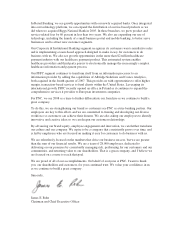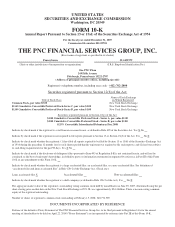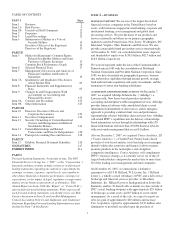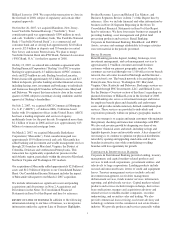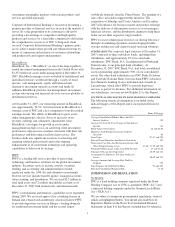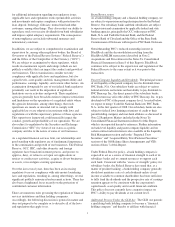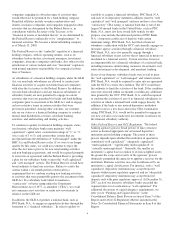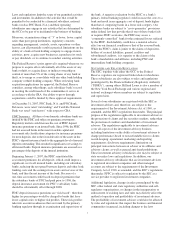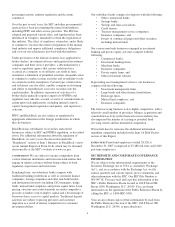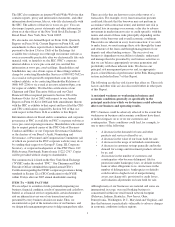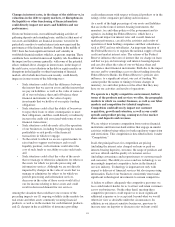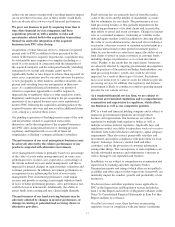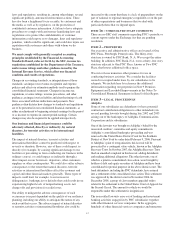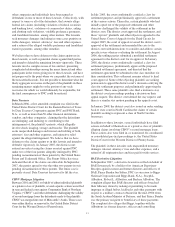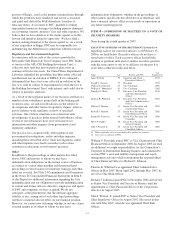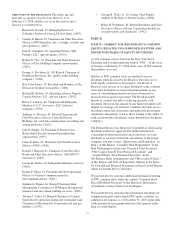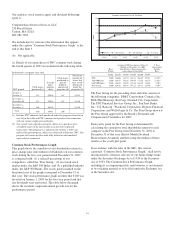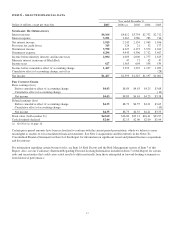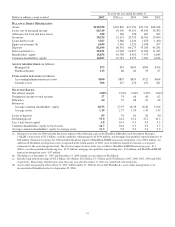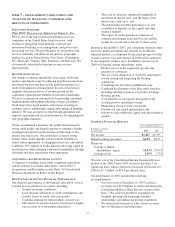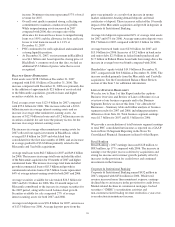PNC Bank 2007 Annual Report Download - page 15
Download and view the complete annual report
Please find page 15 of the 2007 PNC Bank annual report below. You can navigate through the pages in the report by either clicking on the pages listed below, or by using the keyword search tool below to find specific information within the annual report.Changes in interest rates, in the shape of the yield curve, in
valuations in the debt or equity markets, or disruptions in
the liquidity or other functioning of financial markets
could directly impact our assets and liabilities and our
performance.
Given our business mix, our traditional banking activities of
gathering deposits and extending loans, and the fact that most of
our assets and liabilities are financial in nature, we tend to be
particularly sensitive to market interest rate movement and the
performance of the financial markets. Starting in the middle of
2007, there has been significant turmoil and volatility in
worldwide financial markets which is, at present, ongoing. These
conditions have resulted in increased liquidity risk. In addition to
the impact on the economy generally, with some of the potential
effects outlined above, changes in interest rates, in the shape of
the yield curve, or in valuations in the debt or equity markets or
disruptions in the liquidity or other functioning of financial
markets, all of which have been seen recently, could directly
impact us in one or more of the following ways:
• Such situations could affect the difference between
the interest that we earn on assets and the interest that
we pay on liabilities, as well as the value of some or
all of our on-balance sheet and off-balance sheet
financial instruments or the value of equity
investments that we hold or of our equity funding
obligations;
• Such situations could affect the ability of borrowers
to repay their loans or other counterparties to meet
their obligations, and thus could directly or indirectly
increase the credit risk associated with some of our
financial transactions;
• Such situations could adversely affect the operation
of our businesses, including by impacting the nature,
profitability or risk profile of the financial
transactions in which we engage;
• To the extent to which we access capital markets to
raise funds to support our business and overall
liquidity position, such situations could affect the
cost of such funds or our ability to raise such funds;
and
• Such situations could affect the value of the assets
that we manage or otherwise administer for others or
the assets for which we provide processing and
information services. Although we are not directly
impacted by changes in the value of assets that we
manage or administer for others or for which we
provide processing and information services,
decreases in the value of those assets would affect
our fee income relating to those assets and could
result in decreased demand for our services.
Among the situations that could have one or more of the
preceding impacts are (1) ongoing volatility in the markets for
real estate and other assets commonly securing financial
products, as well as in the markets for such financial products,
and (2) changes in the availability of insurance providing
credit enhancement with respect to financial products or in the
ratings of the companies providing such insurance.
As a result of the high percentage of our assets and liabilities
that are in the form of interest-bearing instruments, the
monetary, tax and other policies of the government and its
agencies, including the Federal Reserve, which have a
significant impact on interest rates and overall financial
market performance, can affect the activities and results of
operations of bank holding companies and their subsidiaries,
such as PNC and our subsidiaries. An important function of
the Federal Reserve is to regulate the national supply of bank
credit and market interest rates. The actions of the Federal
Reserve influence the rates of interest that we charge on loans
and that we pay on borrowings and interest-bearing deposits
and can also affect the value of our on-balance sheet and
off-balance sheet financial instruments. Both due to the impact
on rates and by controlling access to direct funding from the
Federal Reserve Banks, the Federal Reserve’s policies also
influence, to a significant extent, our cost of funding. We
cannot predict the nature or timing of future changes in
monetary, tax and other policies or the effect that they may
have on our activities and results of operations.
We operate in a highly competitive environment, both in
terms of the products and services we offer, the geographic
markets in which we conduct business, as well as our labor
markets and competition for talented employees.
Competition could adversely impact our customer
acquisition, growth and retention, as well as our credit
spreads and product pricing, causing us to lose market
share and deposits and revenues.
We are subject to intense competition from various financial
institutions and from non-bank entities that engage in similar
activities without being subject to bank regulatory supervision
and restrictions. This competition is described in Item 1 under
“Competition.”
In all, the principal bases for competition are pricing
(including the interest rates charged on loans or paid on
interest-bearing deposits), structure, the range of products and
services offered, and the quality of customer service
(including convenience and responsiveness to customer needs
and concerns). The ability to access and use technology is an
increasingly important competitive factor in the financial
services industry. Technology is important not only with
respect to delivery of financial services but also in processing
information. Each of our businesses consistently must make
significant technological investments to remain competitive.
A failure to address adequately the competitive pressures we
face could make it harder for us to attract and retain customers
across our businesses. On the other hand, meeting these
competitive pressures could require us to incur significant
additional expenses or to accept risk beyond what we would
otherwise view as desirable under the circumstances. In
addition, in our interest sensitive businesses, pressures to
increase rates on deposits or decrease rates on loans could
10


